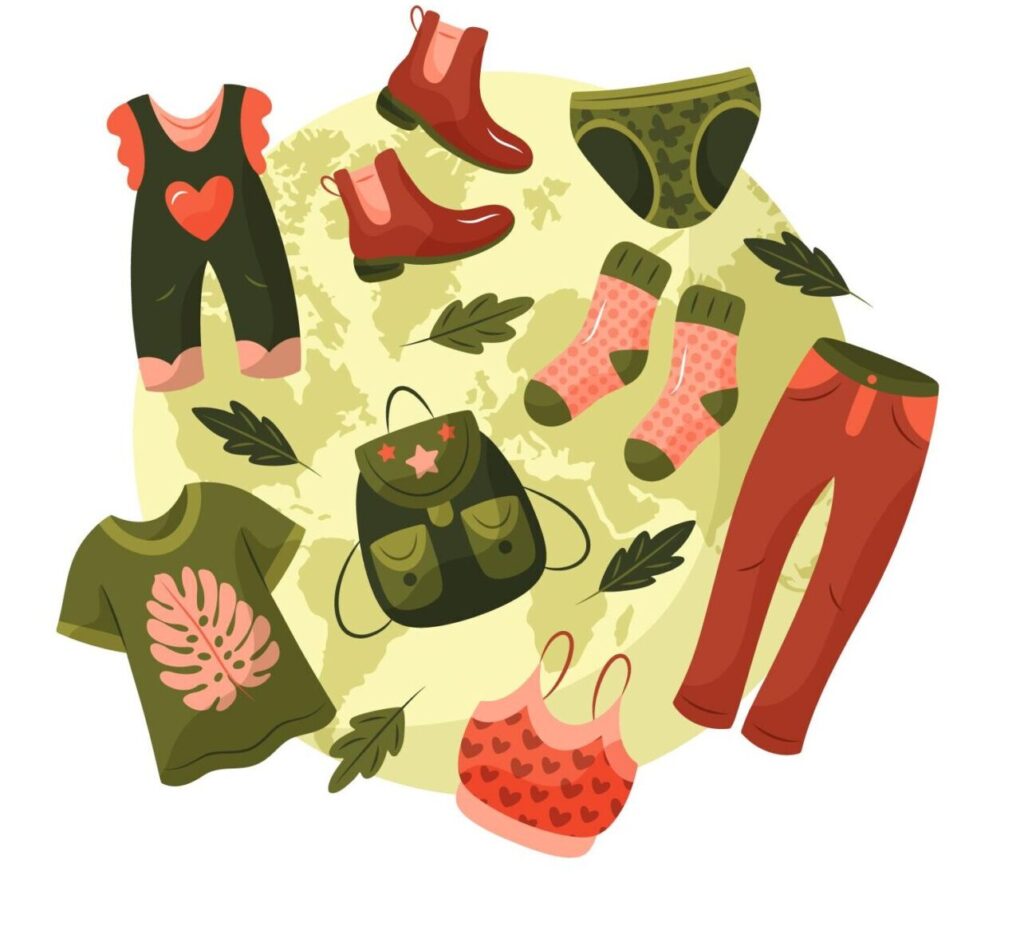1. Upcycled Fashion
Repurposing used or unwanted products into something useful. Recycling breaks down materials to create something new, while upcycling preserves an item’s integrity — usually adding value to it through a clever transformation. This also prevents unnecessary trash from being added to the landfill, while pushing creative bounds in design. Read more:

2. Organic Cotton Cloths
Sustainable fashion, which focuses on environmentally sustainable and socially responsible materials and production methods, is a fast-evolving and progressive branch of fashion, organic cotton clothing contributing to this in a big way. Here’s a closer look at organic clothing, including benefits, essential materials, and some reputable brands:
Benefits of Organic Clothing
- Improves Soil Health: Organic farming systems emphasize crop rotation and cover cropping, composting, and use of natural pest control methods which support soil fertility and biodiversity.
- Reduced Environmental Impact: Organic cotton and other organic materials typically require less water and energy to produce than in standard methods. This is a great way to reduce the overall environmental impact of clothing production. Read more

3. Bamboo Fabric
Bamboo is considered a “green” crop because it is so environmentally friendly. Unlike traditional cotton, which necessitates massive amounts of water and pesticide use, bamboo grows well naturally without the need for any harmful chemicals.
The Production Process of Bamboo Clothing
(Learn more about how bamboo clothing is made.) Knowing how this process works can help consumers to make informed decisions.
-> Harvesting
Bamboo is one of the most sustainable materials, only the culms (stems) are cut while the wound can heal. Hence, bamboo is able to grow again, fast.
-> Processing
There are two main methods for processing bamboo into fabric: mechanical and chemical.
- Mechanical Processing: It’s labour-intensive but eco-friendly, producing the textile bamboo linen.
- Chemical Processing: More common, this method involves using chemicals to dissolve the bamboo cellulose into a viscous solution and then squeezing the solution to make bamboo rayon or viscose. Although this process is not the greenest, there are developments occurring to minimize the use of chemicals. Read more:

4. Plant-Based Fabric
With the fashion and textile industries under ever closer scrutiny of the environmental impact of their practices, plant-based fabrics are stepping in as a much more environmentally friendly (or, at least, less harmful) alternative to the most widely used fabrics. When these manufacturing processes to obtain fibers are from renewable plant resources, indeed, we have fabrics with a wide range of advantages: biodegradability; less carbon footprint; less reliance on fossil fuels. In the following exploration of plant-based fabrics, we will discuss the history, types, production processes, environmental impact, and future potential of this type of material.
Types of Plant-Based Fabrics
- Bamboo: Bamboo fabrics are made from the pulp of the bamboo plant. Bamboo grows rapidly and requires little water, but the chemical processes used to transform it into fabric can be environmentally damaging.
- Ramie: Like linen, ramie is a strong, durable fiber derived from the ramie plant. It is mildew- and insect-resistant, making it a good choice for outdoor textiles. Read more:

5. Slow Fashion
Slow fashion is a reaction to some of the negative impacts created by the rise of fast fashion, which became mainstream in the late 20th century. That was on one level cheap, and on another level exploitative, in terms of the way it was made, what it was made from, how it was seen, how many they made.
Principles of Slow Fashion
- Ethically produced: Slow fashion emphasizes fair labor practices, ensuring individuals were compensated well and worked in safe environments. This is transparency in the supply chain, which gives consumers the opportunity to make informed choices about what they purchase.
- Timeless style: Instead of seasonal trends that appear, fade away, going out of style and back again, slow fashion approaches timeless styles that you can wear season after season. This helps to alleviate the need for new clothes.
- Consumer Education: It is important to educate the consumers on the impact of their fashion decisions. This includes learning about the impact our clothes have on the environment and why it’s important to support ethical brands. Read more

6. Handmade products
They can be hand made as are people focused on craftsmanship rather than production automation which means no large runs of grouped similar products.
Benefits of Handmade Products:
- Quality: Premium fabrics and craftmanship mean they’ll last.
- Uniqueness: Each piece tends to have unique elements, designed for the individuals who get them–there are far fewer of them as compared to pre-made piece.
- Top 10 Reasons to Buy Handmade Goods and Support Local Artisans Cultural Preservation: Many handmade goods preserve traditional craftsmanship and heritage.
- Sustainability: Natural material and relatively few industrial processes have less environmental impact.
- Communities Supported: local artisans, small business, fair trade. Read more:

